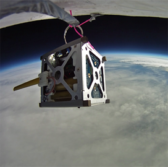 Aerojet Rocketdyne has concluded a series of tests on a three-dimensional printed propulsion system to check engine throughput and propellant tank expulsions as the program moved forward to the qualification phase.
Aerojet Rocketdyne has concluded a series of tests on a three-dimensional printed propulsion system to check engine throughput and propellant tank expulsions as the program moved forward to the qualification phase.
The company said Monday it conducted a hot-fire test of the hydrazine integrated propulsion system on the MPS-120 CubeSat High-Impulse Adaptable Modular Propulsion System to demonstrate functions that meet Technology Readiness Level 6 and Manufacturing Readiness Level 6.
Julie Van Kleeck, vice president of space advanced programs at Aerojet Rocketdyne, said the use of 3D printing technology to manufacture the system could facilitate new opportunities for the company beyond traditional manufacturing.
MPS-120 project engineer Ethan Lorimor said that the team completed the 3D printing process in one week and system assembly work in two days.
The MPS-120 propulsion system is designed to operate with both hydrazine and AF-M315E green propellant and consists of four small rocket engines and feed system components and the 3D‑printed titanium piston, pressurant tank and propellant tank.
NASA‘s Office of the Chief Technologist’s Game Changing Opportunities in Technology Development initiative funds the program.




